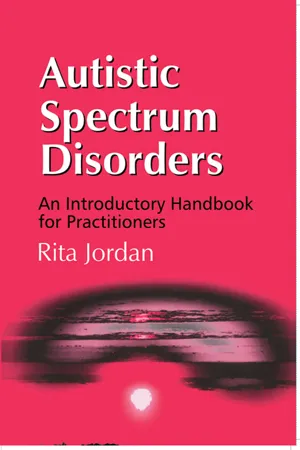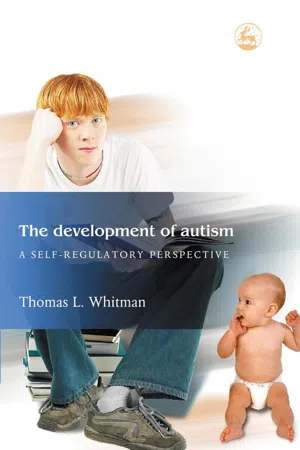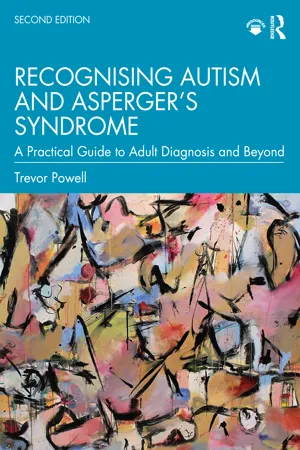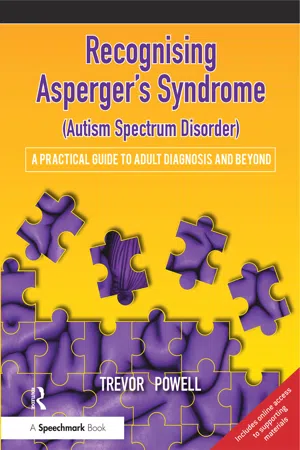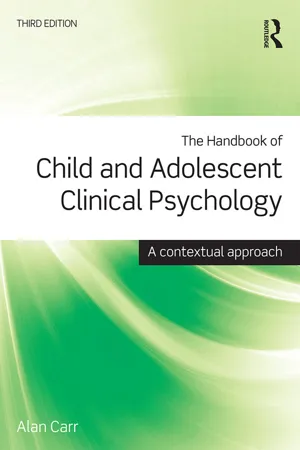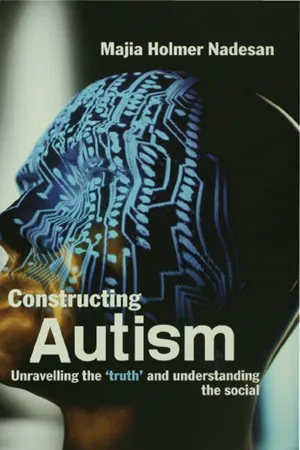Psychology
Theories of Autism
Theories of autism encompass a range of perspectives on the causes and characteristics of autism spectrum disorder (ASD). These theories include genetic, neurological, and environmental factors, as well as the role of social and cognitive processes. Some theories emphasize the importance of early intervention and individualized support for individuals with ASD, while others focus on understanding the underlying neurodevelopmental mechanisms.
Written by Perlego with AI-assistance
Related key terms
9 Key excerpts on "Theories of Autism"
- eBook - ePub
Autistic Spectrum Disorders
An Introductory Handbook for Practitioners
- Rita Jordan(Author)
- 2013(Publication Date)
- David Fulton Publishers(Publisher)
Chapter 5 Psychological Theories on the Nature of AutismIntroduction
As discussed in earlier sections, She level of explanation that is most useful for understanding autism from a treatment perspective is the psychological one. At this level we are dealing with theoretical constructs that help to make sense of observable behaviour, while fitting the constraints imposed by the little we know of the biological basis of that behaviour. Even within the psychological domain, some theories will be closer to biology (neuropsychological theories, for example), some closer to behaviour (learning theories, for example) and some purely abstract (such as information processing theories, based on a computer metaphor of brain functioning or psychodynamic theories based on myth or psychoanalytical theory).Autism is a rich source of psychological theorising. At one level this arises because of the intriguing and bizarre behavioural manifestations of the disorder and the wide variation of behaviours displayed. This means that almost any theory can appear to explain, or at least describe, some of the features of autism and so can come to have face validity. At another level, autism involves a unique and early developmental disturbance that can throw light on the developmental process itself and offer insights into the role played by cognitive, affective (emotional), conative (motivational) and social factors in development. Theories of Autism have a privileged status in developmental psychology, for that reason. For those attempting to live and work with people with autism, there is also the daily challenge that methods and approaches that work with all other groups do not seem to work with these individuals. There is, then, the need to understand what is going on, in order to devise better and more specific approaches. The number and variety of theoretical approaches reflect all of these interests and concerns. - eBook - ePub
The Development of Autism
A Self-Regulatory Perspective
- Thomas L. Whitman(Author)
- 2004(Publication Date)
- Jessica Kingsley Publishers(Publisher)
CHAPTER 3 Theories of Autismwith Kathleen J. KolbergWithin the scientific enterprise, theories about disorders such as autism serve a variety of functions. Some theories are more descriptive, acting as conceptual organizers about what is known. For example, they describe the nature of a disorder, how it develops, and how it differs from other disorders. A more sophisticated theory also allows predictions to be made; for example, about how people with a particular disorder will behave in the future given their present symptoms. In addition to these descriptive and predictive functions, a comprehensive theory formulates hypotheses regarding the critical processes underlying the development of a disorder and speculates about how interventions might be best structured. Theories are not either wrong or right, but rather are more or less useful. Theories that allow more precise and accurate predictions to be made and/or lead to the design of effective interventions are more useful and for that reason are characterized as having greater validity.Theories of Autism can be typically subdivided into those that are psychological or biological. Psychological theories specify the role that different processes, such as those involving the attention or the sensory system, play in symptom development. In contrast, biological theories emphasize how various factors such as genes, neurochemical processes, neurological structures, and environmental toxins influence symptom formation. Ideally, psychological theories should be consistent with what is known biologically about autism. Conversely, biological theories should be consistent with what is known psychologically.A variety of Theories of Autism have been proposed. Many of these theories are quite descriptive and not very formalized in their presentation. Most Theories of Autism are quite speculative and in need of empirical verification. Moreover, most theories are narrow in scope, focusing on only a few of the symptoms associated with autism. Theory formulation in the area of autism is particularly difficult because of the number and heterogeneous nature of the symptoms. At present, it is not clear which symptoms of autism are primary, that is, are a critical part of an early process leading to other symptoms. Ideally a comprehensive theory of autism should emphasize how biological, psychological, and environmental factors can work in conjunction to explain the development of autism. Moreover, to be really useful, a theory of autism should specify how biological and/or psychobehavioral interventions can be structured to address the underlying causes of autism so as to prevent or ameliorate the symptoms associated with this disorder. Although there is empirical support for some Theories of Autism, no one theory has emerged that has gained broad acceptance. Because of the rapidly increasing scientific interest in autism, it is likely that the theoretical landscape will change dramatically in the next decade. - eBook - ePub
- Norah Frederickson, Andy Miller, Tony Cline, Tony Cline, Anthea Gulliford, Susan Birch(Authors)
- 2015(Publication Date)
- Routledge(Publisher)
IIISocial, emotional and behavioural issues in school
9Educating children with autism What use are psychological theory and research? Susan Birch and Norah Frederickson CHAPTER SUMMARY
In this chapter, you will learn about some of the challenges teachers face in educating children with autism. We begin by asking ‘What is autism?’, describing and illustrating key characteristics of autism and discussing associated difficulties and strengths. We then consider what is currently known about what causes autism, looking briefly at some controversies surroundingprevalence and diagnosis in particular. Recognising the crucial explanatory role of cognitive-level explanations in autism, three prominent cognitive Theories of Autism are reviewed: theory of mind, executive dysfunction and central coherence. Finally, we examine the significant role that psychological theory and research have played in developing approaches to the education of children who have autism. Two distinct strands of influence are identified, one that draws on behavioural psychology and takes no specific account of diagnostic features of autism, and one that draws directly on cognitive Theories of Autism. Examples of associated intervention programmes are described, together with ethical and methodological issues relating to their implementation and evaluation.LEARNING OUTCOMES
When you have studied this chapter, you should be able to:1 describe the triad of impairments that characterise autism spectrum disorder s;2 explain the principal cognitive Theories of Autism and the research designs that have been used to investigate them;3 evaluate the theoretical and research bases of educational approaches for children with autism spectrum disorders.WHAT IS AUTISM?
Autism was first described by Kanner, an American psychiatrist, in 1943, through the presentation of a number of case studies of children who shared certain characteristics: ‘autistic aloneness’ and ‘desire for sameness’. In addition, Kanner identified ‘islets of ability’ in some of these children, such as phenomenal memory for poems or names and precise recall of complex patterns. The difficulties experienced by children with autism were systematically investigated across a whole population of children by Wing and Gould (1979) and characterised as a ‘triad of impairments’: in reciprocal social interaction, verbal and nonverbal communication, and imagination. The major international diagnostic classification systems, DSM-IV-TR (American Psychiatric Association, 2000) and ICD-10 - eBook - ePub
Recognising Autism and Asperger's Syndrome
A Practical Guide to Adult Diagnosis and Beyond
- Trevor Powell(Author)
- 2021(Publication Date)
- Routledge(Publisher)
CHAPTER 2Theories and facts about autism
What we know
Autism is a highly complex neurodevelopmental condition. Understanding of the condition has developed and changed significantly over the past 70 years, but its causes are still poorly understood. There is not one single theory of autism, but many different theories which together contribute to our understanding. This chapter will consider two key areas of theory and research. First, theories that look at the mind of people with autism; how information is processed, thinking and behaviour. Second, theories that focus on the biological level; looking at genetics, hormones and the make-up and connectivity of the brain. Let's start with a few basic facts about autism:- Autism is a neurodevelopmental biogenetic condition, which means it is something a person is born with.
- Autism is not caused by bad parenting; it is definitely not the parents’ fault. Theories in the 1950s and 1960s which used terms such as ‘refrigerator mother’ to suggest inadequate parenting were damaging, misguided, misleading and wrong.
- Autism is a lifelong condition. Autistic people may change, develop new skills or learn to mask traits associated with the condition, but talking about a ‘cure’ in a medical sense is not helpful.
- Autism has strong genetic links and runs in families, but there is consensus that there is no one single genetic difference. We do not know which particular genes are involved.
- Autism is best thought of as an umbrella term, which describes a range of different people, all with relatively similar behaviours.
- Autism is a spectrum condition. Like all people, autistic people have certain difficulties, to a greater or less extent, but being autistic will affect them in different ways. All autistic people are different.
- There is no link between the onset of autism and vaccination.
- Autism is more common in males than females. However, it is suggested that females are often not diagnosed because they learn to ‘camouflage’ their condition.
- eBook - ePub
Recognising Asperger's Syndrome (Autism Spectrum Disorder)
A Practical Guide to Adult Diagnosis and Beyond
- Trevor Powell(Author)
- 2017(Publication Date)
- Routledge(Publisher)
Chapter Two Theories and facts about autism and Asperger’s syndrome1 What we know
We recognise that autism itself is a highly complex neurodevelopmental condition and that the causes too are complex and poorly understood. In this chapter we will look at what we know, including some of the facts and theories.- It is a neurodevelopmental biogenetic condition, which means it is something a person is born with.
- People with autism have brains that are wired differently which affects the way information is processed in the brain.
- We know that autism is not caused by bad parenting; it is definitely not the parents’ fault. Theories years ago around inadequate parenting were very damaging, misguided and misleading.
- It is a lifetime condition although people change and develop new skills and may move out of the diagnostic range. Talking about a ‘cure’ is not helpful.
- It is highly hereditary with strong genetic links and runs in families, but we do not know which particular genes are involved.
- It is a spectrum condition, so it is on a continuum or range from mild to severe. Some would argue that it tails off in its milder form into personality characteristics. It is not a straightforward spectrum, but one which has different constellations and many diverse forms.
- We don’t really know much about what causes it, but we do know there is no link between the onset of autism and vaccination.
- Gender ratio: It is more common in males than females, although the estimated ratio has gone down from 10:1 to 3:1 in the past few decades.
2 Theory of mind
Figure 2.1 : Theory of mindThe theory of mind (ToM), sometimes referred to as ‘mindreading’ or ‘mentalising’, refers to a person’s ability to recognise and understand the thoughts, beliefs, intentions, feelings and desires of others in order to make sense of their behaviour and predict what they are going to do next. Colloquially it means ‘putting yourself in somebody else’s shoes’ or reading the intention of another. This involves taking a perspective other than your own. It also involves being able to reflect on your own thoughts and feelings – to stand back and look at yourself. The theory goes back to the seventeenth-century French philosopher Rene Descartes. If a person has difficulty taking the perspective of another, they are more likely to be puzzled by the action of others, have difficulty recognising and working out the feelings of others and are likely to find people unpredictable. If a person is not able to ‘read’ another person, they are more likely to encounter misunderstandings and have greater difficulties resolving conflicts. For example, they might wonder why someone is looking at somebody else in a particular way or why somebody spoke in a particular way. As a consequence of this they are also more likely to have lower levels of empathy, because they have difficulty picking up the cues that somebody might be upset. Without a good ToM life can be unpredictable and very scary. - eBook - ePub
Child and Adolescent Psychopathology
Theoretical and Clinical Implications
- Cecilia A. Essau(Author)
- 2012(Publication Date)
- Routledge(Publisher)
10 Autism A psychological perspectiveHanna Kovshoff, Corinna F. Grindle, and Richard P. HastingsFirst identified in 1943 by Leo Kanner, autism affects an individual’s ability to communicate verbally and non-verbally, interact socially, play imaginatively, and relate to those around them. Autism is a spectrum disorder such that it affects individuals differently, and with varying degrees of severity. It is estimated that between 3.3 and 16 children per 10,000 are affected with autism, taking into account differing diagnostic criteria, genetic factors, environmental influences, and/or case finding methods of a range of epidemiological studies. The latest incidence rates of persons living with autism spectrum disorders in the United Kingdom, according to the National Autistic Society, are 91 per 10,000, and 1 in 1000 (Bryson, 1997) in the United States. Autism is three to five times more likely to affect boys than girls (American Psychiatric Association 1994; Klinger and Dawson, 1996).Autism is not a behavioural disorder; however, diagnosis relies on the presence, as well as the absence, of various key behaviours. It is a lifelong, complex neurodevelopmental disability, which affects central nervous system and brain functioning. Behaviours commonly associated with autism may become apparent by the time the child reaches the age of 18 months, and are usually present by 3 years of age. As described in the DSM-IV (APA, 1994) and the ICD-10 (WHO, 1992) diagnostic manuals, autism is characterized by a pattern of deficits in social behaviour, communication, and imagination, and is associated with repetitive and/or stereotypical patterns of behaviours or interests. Autism forms part of a subcategory of Pervasive Developmental Disorders (DSM-IV; APA, 1994) which are characterized by severe and lifelong impairment in multiple areas of development. These areas of impairment are relative to the individual’s developmental level or mental age (DSM-IV; APA, 1994). Apart from autism spectrum disorder, pervasive developmental disorders include Rett’s disorder, child disintegrative disorder, Asperger’s disorder, and pervasive developmental disorder – not otherwise specified (PDD-NOS). All of these conditions have in common that they are evident in the first year of life, and most are associated with some level of intellectual disability. Autism occurs at all intelligence levels, although it is widely believed that approximately 75 percent of persons with autism also have associated learning difficulties and a below average intelligence quotient (IQ), while approximately 25 percent of individuals with autism have average or above average intelligence (Newsom, 1998; Sigman, 1998). It is noteworthy to say that tests of intelligence and cognitive potential find a different pattern of performance than other children with intellectual disabilities. Autism is associated with a pattern of strengths and weaknesses characterized by deficits in abstract and conceptual thinking, receptive and expressive language, and socially related tasks. Conversely, non-verbal performance, and visual spatial and motor skill areas are often better developed (Happé, 1994; Shah and Frith, 1993; Volkmar et al., 1997). - eBook - ePub
The Handbook of Child and Adolescent Clinical Psychology
A Contextual Approach
- Alan Carr(Author)
- 2015(Publication Date)
- Routledge(Publisher)
Table 9.3 .Table 9.3 Theories of ASDTheory type Sub-type and source Principles Psychodynamic theoryBettelheim (1967) Autistic withdrawal occurs as a response to inadequate parenting. Echolalia and insistence on sameness are an expression of hostility associated with unmet needs. Long-term non-directive psychotherapy offers a substitute for the inadequate parent–child relationship and leads to a reduction in withdrawal and expressions of hostility. Biological theoriesNeurodevelopmental theory Gillberg & Coleman (2000) ASD is a group of neurodevelopmental disabilities or syndromes which reflect injury to a final common pathway. This may be caused by many different disease processes involving genetic factors, intrauterine insults, or peri-natal factors or some combination of these.Intense world theory The core pathology of the autistic brain is hyperreactivity and hyperplasticity of local neuronal circuits which leads to hyperperception, hyperattention, and hypermemory, and in response social withdrawal and engagement in repetitive behaviour occurs.Broken mirror theory Iacoboni & Dapretto (2006) ; Oberman & Ramachandran (2007) ; Williams et al. (2001)A dysfunction of the motor neuron system underpins the social communication deficits in ASD. The mirror neuron system is the set of brain regions which are active both when a person performs an action and when they observe another person performing the same action.Broadband cognitive theoriesMindblindness/theory of mind, empathizing-systematizing and extreme male brain theory Baron-Cohen et al. (2005) Mindblindness theory proposed that the social and communicative features of ASD are due to an inability to form cognitive representations of other’s mental states, that is to have a theory of mind. This prevents people with ASD from empathizing with others. Empathizing-systematizing theory (an extension of mindblindness theory) proposes that while the social and communicative features of ASD are due to theory-of-mind and empathy deficits, the restrictive, repetitive behaviour, obsessional features and islets of ability features of ASD are due to intact or superior systematizing abilities. - eBook - ePub
Constructing Autism
Unravelling the 'Truth' and Understanding the Social
- Majia Holmer Nadesan(Author)
- 2013(Publication Date)
- Routledge(Publisher)
Autism Research Review International reflects, perhaps, a naive realism that Husserl would have rejected, it incorporates the idea that autistic children are somehow “free” from the everyday assumptions that “distort” normal perception. Viewed from this perspective, autism leads to particular perspicuity in some aspects of perception.However, in contrast to the position outlined above, most cognitive researchers today reject the idea that disturbed social relationships engender a special insight into the essence of experiences, although some cognitivists argue these disturbances may engender a particular cognitive style possibly leading to technical expertise. Notwithstanding this possibility for exceptional skills in some gifted people with autism, most of the research within the cognitive paradigm holds it is the autistic person’s disturbances in perception that define their disability: thus, within the cognitive paradigm, it is autistic person’s failure to engage in the social world, as mediated by social patterns of perception, that explains or describes their cognitive deficiency. Some researchers believe that autistic people’s failure to acquire socially shared mental structures leads to sensory distortions and/or the inability to integrate sensory data meaningfully. This view contrasts with Asperger’s idea that his patients had particularly objective acuity of perception. Discussion now turns to the cognitive paradigm’s approach to the problem of perception and the development of autism.Following the theoretical traditions outlined previously, most cognitive psychological research views all meaningful perception as being mediated by mental structures and/or mental representational frameworks and thereby differs from accounts that suggest the possibility for unmediated perception. Thus, cognitive psychologists see humans as making sense of their world through their acquired or innate cognitive structures. They view consciousness (and/or “mind”) as dependent on these structures for the contents of its experiences. Following the Kantian philosophical tradition, some cognitive psychologists believe the mentalist structures organizing sensory data are a priori - eBook - ePub
Re-Thinking Autism
Diagnosis, Identity and Equality
- Sami Timimi, Rebecca Mallett, Katherine Runswick-Cole(Authors)
- 2016(Publication Date)
- Jessica Kingsley Publishers(Publisher)
It is of little value to attempt to quantify the relative influence of the two [genes and environment] in any precise way, because it will vary by population and over time. Moreover, the precise estimates for the strength of genetic and of environmental influences have few policy or practice implications. (Rutter 2006, p.221)By the 1980s much research was underway to try to find the biological cause of autism. This necessitated that psychiatrists and psychologists develop new theoretical concepts to give researchers a practical way forward for their investigations. Thus it was proposed that a lack of Theory of Mind (ToM) was the central deficit found in autism. ToM refers to the ability to understand that other people have their own plans, thoughts, beliefs, attitudes and emotions. It was suggested that there was an underlying cognitive structure responsible for ToM, which was viewed as an innate ‘module’ that is activated at around three years of age. The ToM Module (ToMM) was seen as dedicated, specific, fast, automatic, at least partly encapsulated, and its functioning as being largely independent of the general intellectual capacities of the individual (Baron-Cohen 1995). Autistic children were found to have a significantly lower performance on certain tasks said to measure ToM compared with other cognitive tasks for testing intelligence and language capacities, leading to the hypothesis that autism was the consequence of a specific (biological) deficit in the ToMM.However, by the late 1990s, interest in ToM was waning. As the diagnosis of autism was increasing, no genes responsible for the ToMM had been found, inconsistencies in ToM findings were apparent, the diagnosis was being made mainly in males, and interest in behavioural and biological continuums was increasing (Timimi, Gardner and McCabe 2010).Moving away from the idea that autism is caused by a discrete pathology, Professor Simon Baron-Cohen put forward the ‘extreme male brain’ theory of autism. His new theory was the first to properly recognise that a theory of causation must be able to explain the gender disparity (with the majority receiving a diagnosis being male) and so he concluded that people with autism simply match an extreme of the male profile, with a particularly intense drive to systemise and a low drive to empathise. In other words, autistic traits are biologically male, normally distributed, found as a continuum in the population, and autism is simply the extreme end of this (male) continuum (Baron-Cohen 2003).
Learn about this page
Index pages curate the most relevant extracts from our library of academic textbooks. They’ve been created using an in-house natural language model (NLM), each adding context and meaning to key research topics.
